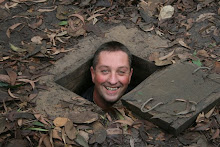
Our first view of the Grand Canyon was utterly overwhelming. No matter how many wonderful landscapes you’ve seen; nothing can prepare you for this. The Grand Canyon is vast, the enormity of its scale absolutely incomprehensible. Too grand for our field of vision, our brain simply cannot compute its magnitude. Gorges blend into gorges, cliffs into cliffs, 8ft cacti appear like blades of grass and distances become jumbled.
On a clear winter day, like we had on our second day, we could see 130 miles west down the canyon to Mt Trumbull. We were lucky, in the summer visibility averages 60 miles. I’m not sure if I consider the canyon beautiful, but it certainly is dramatic – a maze of rugged battlements lined with cliffs plummeting thousands of metres into deep gorges and punctuated by towering temples, it exudes a kaleidoscope of ruddy hues – reds, yellows, oranges and browns in horizontal layers – slice after slice of ancient landscape laid bare in all its magnificent glory. The sun bounced warmly off the red sandstone but the canton seemed desolate, vacant, distant and uninviting. It was important to get down amongst its sheer walls to see and feel its inner character.
We took the South Kaibab Trail towards Skeleton Point. 360°vistas encircled us every step. Jumbles of sandstone blocks towered above us and suddenly the canyon looked vulnerable. The trail was rough and sandy and the different sedimentary layers we trekked through were clearly marked with sudden colour changes underfoot. We passed Oo-ah Point and Cedar Ridge 1 mile below the south rim of the canyon, but still; most of our view was down. We were however, very much inside the canyon, if not in the inner gorges, my calf and thigh muscles testified to that the next day – walking out of the Canyon was a tough one. No wonder those mules have such large backsides!

The first night, we watched the sun set at Hope Point, west of the Canyon Village. Its cold at night here and as the sun disappeared behind us the depths of the canyon became grey and foreboding, whilst the temple points and amphitheatre type cliffs glowed a burnt orange. Gazing into the depths of the canyon that evening, it was great to just to contemplate life. We took in several view points during our stay – Mather Point (the first and most memorable), Hopi, Powell, Pima (where granite rapids rumbled up the valley), Hermits Rest and along the East Side, Grand View and Desert View – a great one of the river, sheer canyon walls (palisades) and the desert plains. No matter how much I looked at the canyon with maps and diagrams I couldn’t make much sense of the maze of creeks, gorges, island type temples, buttresses and battlements – with a flight directly over the top I thought we’d get a good overview. Flight seeing is always fantastic, but soaring over the canyon in a helicopter is unbeatable. As we left the Kaibab Forest and plunged over the South Rim, the canyon came full into view and we were filled with a surge of adrenalin and awe – the canyon was spectacular from here, even more so that from the rim – the river was in view and routes through the maze clear. The canyon just made sense from the air. It was a wonderful 40 minute flight and I felt I knew the Grand Canyon a little better now. It is definitely a wonder we will never forget.



